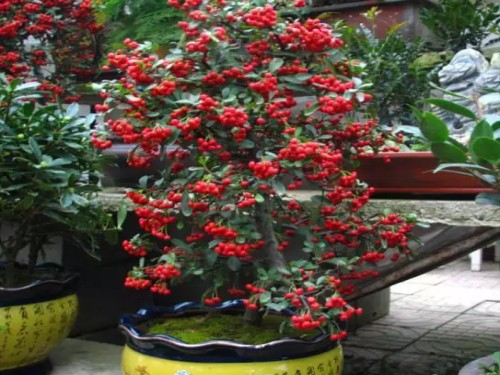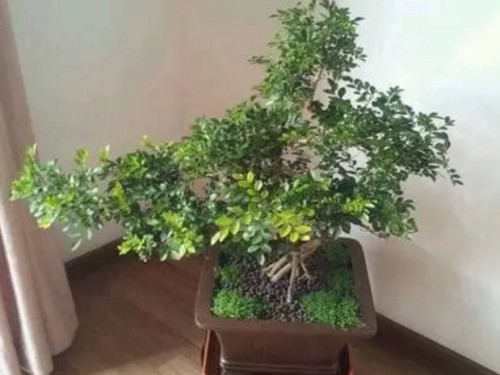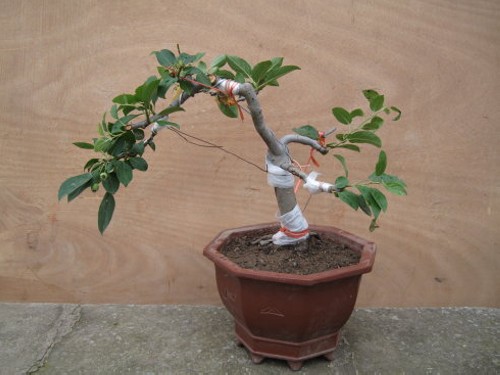Maintenance method of bonsai of winter red fruit
Winter red fruit alias pear blossom begonia, also known as longevity fruit, Christmas red fruit, for Rosaceae, apple genus, deciduous shrubs or small trees, is the production of flowers, fruit bonsai in a good product. As a result, the fruit is as blue as Jasper in summer, red as red in autumn, not only does not fall in winter, but also as red as a red pearl. In August, flower buds formed and gradually blossomed purple florets. The fruit will turn red gradually in October after sitting in September.
Winter red fruit is a variety of apple, its tree shape is compact, the spring light pink flowers are full of branches, the autumn and winter trees are covered with exquisite and lovely fruit, its fruit shape is very similar to apple, suitable for garden planting or potted ornamental, bonsai production. The following is to introduce the maintenance methods of winter red fruit bonsai.

Soil:
Winter red fruit is resistant to cold and is afraid of damp and hot. It is suitable to grow in sandy soil which is rich in humus, loose and fertile and well drained.
Lighting:
Winter red fruit likes the sunny and cool dry environment, generally transplanting or potting in spring every year, the growing period requires sufficient sunshine, if the light is insufficient, it will affect the color, plant shape and fruit of the fruit, so the ground planting can be planted in the sunny ventilation place in the courtyard, and the potted plant should be placed in a sunny place.
Temperature:
Winter red fruit is not resistant to high temperature, if it is higher than 35 ℃ for a long time in summer, it can be properly shaded and ventilated to cool down. In winter, potted plants can bury the flowerpot in outdoor shelter or in a cold room of 0 ℃ to 10 ℃ to survive the winter.
Watering:
During the growing period of winter red fruit, the soil is moist without stagnant water. June of each year is the flower bud differentiation period. Watering should be controlled for 2 to 3 weeks and then watered when the young leaves wilt so as to promote the formation of flower buds.
Fertilization:
Nitrogen fertilizer can be properly increased in the early stage of plant growth, and after June, the application of nitrogen fertilizer can be controlled or stopped, and the application amount of phosphorus and potassium fertilizer and trace elements such as calcium and magnesium can be increased to improve fruit quality and ornamental effect, and enrich the development of branches, which is beneficial to the formation of flower buds.
Trim:
The tender tip of the top of the branch should be removed in time to prevent the extension of the branch and redistribute the nutrition, which is beneficial to the development of the fruit. Pruning and shaping the plant before germination in spring, cutting off diseased branches, cross branches, overdense branches and overgrown branches, and truncating the overlong branches to facilitate ventilation and light transmission, and to keep the tree shape graceful.
Change the basin:
Winter red fruit is generally changed every year to 2 years before spring germination, basin soil can be used rotten leaf soil, garden soil, 0.5 parts of coarse sand, and add a small amount of hoof or mature animal manure as base fertilizer.
Diseases and insect pests:
There are few diseases and insect pests in winter red fruit, the main diseases are bacterial leaf spot, gray mold, fungal leaf spot, aphids and heart-eating insects.
Time: 2019-06-01 Click:
- Prev

How to raise small leaf sandalwood bonsai
Red sandalwood is one of the precious woods recognized in the world. And the most precious of all is the loaf of sandalwood. The best lobular rosewood is not in our country, nor in Africa, where it was originally grown, but in India today. So Indian lobular rosewood is one of the best quality
- Next

What if the bonsai leaves of winter red fruit turn yellow? How to raise winter red fruit?
The winter red fruit is easy to bloom, the fruit setting rate is high, the fruit is all red, and the hanging fruit period can be extended to the flowering and long leaves of the following year without falling off. it is an excellent variety of bonsai and is deeply loved by the people. However, in the process of cultivation, the leaves are often yellowed and shedding due to the limitation of basin capacity and other effects.
Related
- Fuxing push coffee new agricultural production and marketing class: lack of small-scale processing plants
- Jujube rice field leisure farm deep ploughing Yilan for five years to create a space for organic food and play
- Nongyu Farm-A trial of organic papaya for brave women with advanced technology
- Four points for attention in the prevention and control of diseases and insect pests of edible fungi
- How to add nutrient solution to Edible Fungi
- Is there any good way to control edible fungus mites?
- Open Inoculation Technology of Edible Fungi
- Is there any clever way to use fertilizer for edible fungus in winter?
- What agents are used to kill the pathogens of edible fungi in the mushroom shed?
- Rapid drying of Edible Fungi

